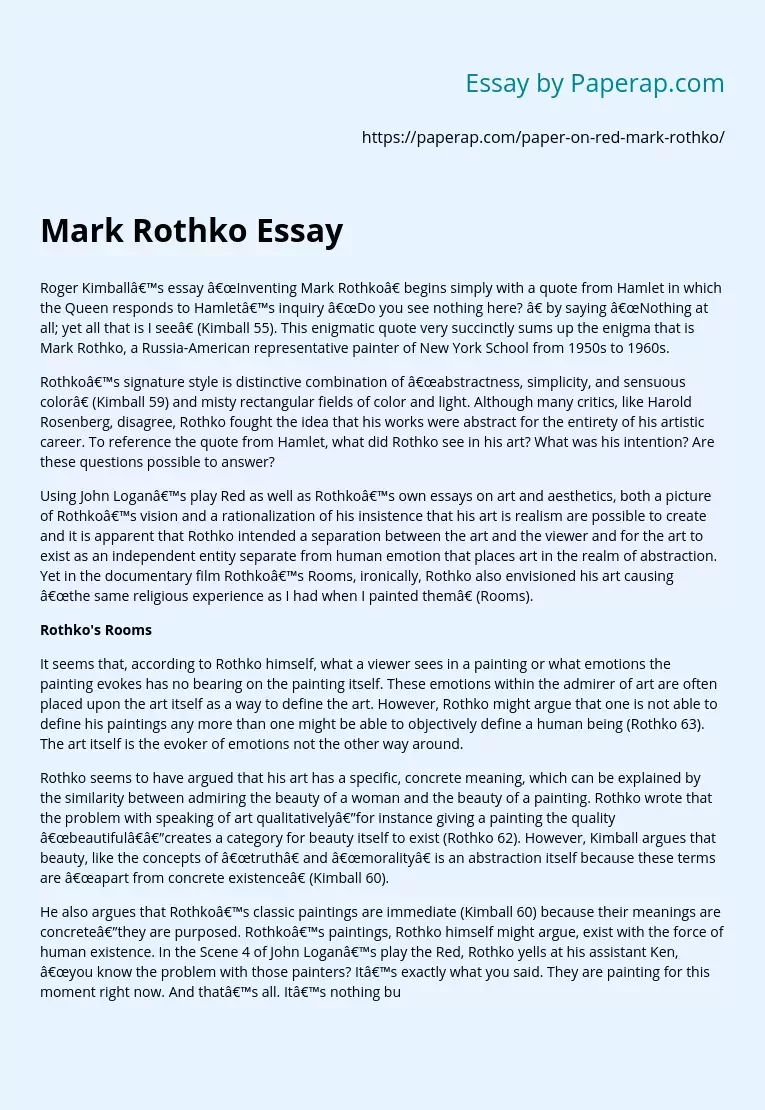Mark Rothko Essay
Roger Kimball’s essay “Inventing Mark Rothko” begins simply with a quote from Hamlet in which the Queen responds to Hamlet’s inquiry “Do you see nothing here? ” by saying “Nothing at all; yet all that is I see” (Kimball 55). This enigmatic quote very succinctly sums up the enigma that is Mark Rothko, a Russia-American representative painter of New York School from the 1950s to 1960s.
Rothko’s signature style is a distinctive combination of “abstractness, simplicity, and sensuous color” (Kimball 59) and misty rectangular fields of color and light.
Although many critics, like Harold Rosenberg, disagree, Rothko fought the idea that his works were abstract for the entirety of his artistic career. To reference the quote from Hamlet, what did Rothko see in his art? What was his intention? Are these questions possible to answer?
Using John Logan’s play Red as well as Rothko’s own essays on art and aesthetics, both a picture of Rothko’s vision and rationalization of his insistence that his art is realism is possible to create and it is apparent that Rothko intended separation between the art and the viewer and for the art to exist as an independent entity separate from human emotion that places art in the realm of abstraction.
Yet in the documentary film Rothko’s Rooms, ironically, Rothko also envisioned his art causing “the same religious experience as I had when I painted them” (Rooms).
It seems that, according to Rothko himself, what a viewer sees in a painting or what emotions the painting evokes has no bearing on the painting itself.
These emotions within the admirer of art are often placed upon the art itself as a way to define the art. However, Rothko might argue that one is not able to define his paintings any more than one might be able to objectively define a human being. The art itself is the evoker of emotions, not the other way around.
Rothko seems to have argued that his art has a specific, concrete meaning, which can be explained by the similarity between admiring the beauty of a woman and the beauty of a painting. Rothko wrote that the problem with speaking of art qualitatively—for instance giving a painting the quality “beautiful”—creates a category for beauty itself to exist. However, Kimball argues that beauty, like the concepts of “truth” and “morality” is abstraction itself because these terms are “apart from concrete existence”.
He also argues that Rothko’s classic paintings are immediate because their meanings are concrete—they are purposed. Rothko’s paintings, Rothko himself might argue, exist with the force of human existence. In Scene 4 of John Logan’s play the Red, Rothko yells at his assistant Ken, “you know the problem with those painters? It’s exactly what you said. They are painting for this moment right now. And that’s all. It’s nothing but zeitgeist art”.
This representation of Rothko shows how Rothko himself might have differentiated his own art from the art of painters like Andy Warhol. Based on Rothko’s essay The Artists Dilemma and this quote from Logan’s play, Rothko would have argued that paintings like those of Warhol’s are real abstractions because they are based on a particular moment in time. An individual moment, alienated from the whole history of time, is truly apart from concrete existence.
Existence is more the totality of time, space, and history, and Rothko’s paintings are, as he seems to have suggested, as purposed as any living creature. In “The De-definition of Art” by Harold Rosenberg, he argues against this idea, saying that “[Rothko’s] were the first ‘empty’ paintings by an American to make an impact on the public, perhaps because his emotionally charged reds, blues, browns, black-greens succeeded in stirring up feelings—awe, anguish, release—too deeply buried to be brought to the surface by visual metaphors” (Rosenberg 105).
With this definition, Rosenberg argues that the viewer and the painting itself are interconnected and the painting can hold no objective existence independent of the viewer. When the audience views the painting and experiences these emotions, it attaches these emotions to the painting. However, Rothko argued that to speak of art in this way—qualitatively—is to give these emotions themselves an independent existence (Rothko 62). Rosenberg called Rothko’s style an “all-embracing symbolic format.
Rosenberg essentially equated Rothko’s paintings with a literary metaphor in which one thing—a painting in this instance—stands for something wholly different, acting as a symbol. Most dictionaries agree on the definition of the word “symbol” as a physical object that stands for an abstraction or a sign with some specific meaning. Rosenberg’s terminology may then not be totally off-kilter. Does not Rothko himself argue that paintings often evoke particular abstract feelings in the admirer?
In this way, are not paintings like symbols, standing in as physical objects for abstract emotions? —not exactly. To view art in this way is to say that the artist intended for an artwork to be symbolic of, let’s say, the sublime. Yet, the viewers, experiencing a piece for the first time, come naked in their emotions as a child experiencing the world for the first time. Whatever emotions the viewer might feel are a product of their own mind rather than a product of the art itself. This is where Rosenberg is most incorrect and where he diverges from Rothko’s apology of his art.
Mark Rothko Essay. (2019, Dec 05). Retrieved from https://paperap.com/paper-on-red-mark-rothko/

